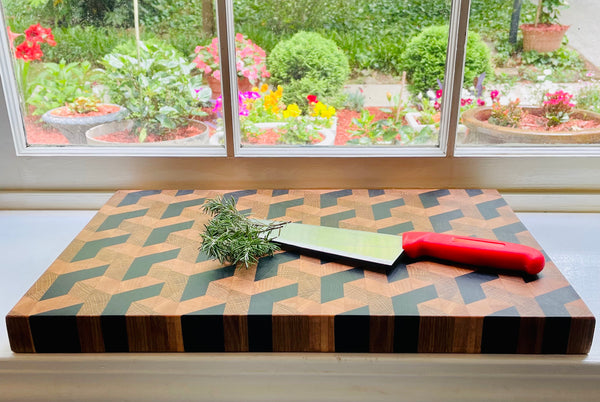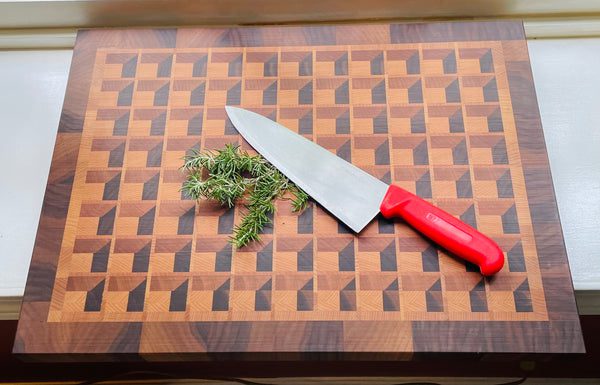End grain cutting boards offer visually appealing patterns due to the orientation of wood fibers. The patterns are created by cutting wood at a 90-degree angle to the grain.
This unique arrangement enhances the durability and longevity of the cutting board. Crafted with precision and attention to detail, end grain cutting boards are not only functional but also serve as stunning pieces of kitchen decor. The intricate patterns add a touch of elegance to any kitchen space while providing a sturdy surface for cutting and chopping.
Whether you prefer a simple checkerboard design or a more intricate geometric pattern, end grain cutting boards are a versatile and stylish addition to your culinary arsenal.
The Art Of End Grain Cutting Boards
Discover the intricate beauty of end grain cutting boards patterns, where wood fibers create visually stunning designs. These boards showcase a unique blend of functionality and artistry, providing a durable and striking addition to any kitchen. Crafted with precision, they offer an elegant and practical solution for home chefs and design enthusiasts alike.
Understanding End Grain Vs. Edge Grain
End grain cutting boards utilize the ends of wood pieces, providing a unique pattern compared to edge grain boards.
- End grain exposes the growth rings for a visually appealing design.
- Edge grain involves cutting along the board’s length, resulting in a different aesthetic.
Benefits Of End Grain Cutting Boards
End grain cutting boards are highly favored for their durability and knife-friendly design.
- Resistant to knife marks due to the wood fibers facing upwards.
- Self-healing properties make end grain boards long-lasting.
Creating end grain cutting boards is a meticulous craft that merges functionality with aesthetic appeal.
Artisans meticulously arrange wood pieces to form intricate patterns, highlighting the natural beauty of the wood.

Credit: theprodigalcarpenter.net
Mesmerizing Patterns
Geometric Designs
End grain cutting boards showcase an array of mesmerizing geometric patterns that enhance kitchen decor.
Wood Species And Patterns
Various wood species used in end grain cutting boards result in unique and eye-catching patterns, adding charm to your kitchen.
Craftsmanship Techniques
Cutting And Arranging End Grain Pieces
Cutting and arranging end grain pieces require precision and attention to detail. Craftsmen carefully cut the wood into small pieces, ensuring that each piece is of the same size and thickness. These pieces are then arranged to create intricate patterns and designs, such as checkerboard or herringbone, adding a unique and visually appealing touch to the cutting board.
Finishing And Polishing
Finishing and polishing the end grain cutting board is a crucial step in the craftsmanship process. After the pieces have been arranged and glued together, the surface is sanded to remove any rough edges and to create a smooth, uniform finish. Following this, the cutting board is polished to enhance the natural beauty of the wood, ensuring durability and a long-lasting, attractive appearance.

Credit: www.reddit.com
Practical Appeal
End grain cutting boards are not only a stylish addition to your kitchen, but they also offer practical appeal that sets them apart from other types of cutting boards. With their unique patterns, durability, and knife-friendly surface, these cutting boards are a popular choice among chefs and home cooks alike. Let’s explore two key aspects of their practical appeal: durability and knife-friendly surface, and maintenance tips to keep them in optimal condition.
Durability
End grain cutting boards are renowned for their exceptional durability. The construction of these boards involves arranging the wood fibers vertically, creating a sturdy surface that can withstand heavy use. This design feature prevents the cutting blade from directly contacting the wood grain, reducing the likelihood of damage to both the board and your knives.
Additionally, the vertical wood fibers of end grain boards act as a natural self-healing mechanism. When you make a cut, the fibers open up to accommodate the blade, and then they close back together, effectively minimizing any visible marks or grooves. This feature not only safeguards your knives but also ensures the longevity of your cutting board.
Knife-friendly Surface
End grain cutting boards offer a knife-friendly surface that is gentle on your blades. The vertical orientation of the wood fibers acts as a cushion, allowing the knife to slide between the fibers rather than cutting through them. This reduces wear and tear on the cutting edge, preserving its sharpness for longer periods.
The knife-friendly surface also helps to maintain the cleanliness of your cutting board. The fibers of the end grain tend to close up after each cut, minimizing the chances of food particles getting trapped in the surface. This makes it easier to clean the cutting board and avoid cross-contamination between different ingredients.
Daily Cleaning
- Rinse the cutting board with warm water to remove loose food particles.
- Use a mild dish soap and a sponge or soft brush to gently scrub the board.
- Rinse thoroughly and dry with a clean towel or let it air dry upright.
Regular Oil Treatments
Periodically applying food-grade mineral oil to your end grain cutting board can help maintain its beauty and durability.
- Start with a clean, dry cutting board.
- Using a clean cloth, apply a thin layer of mineral oil to all surfaces.
- Allow the oil to penetrate the wood for a few hours or overnight.
- Wipe off any excess oil with a clean cloth.
Regular oil treatments will help prevent the wood from drying out and minimize the risk of cracking or warping. Be sure to follow the manufacturer’s instructions or consult with a professional if you are unsure about the specific oil treatment for your cutting board.
By understanding the durability and knife-friendly surface of end grain cutting boards, along with proper maintenance tips, you can enjoy the practical appeal of these versatile kitchen tools for years to come.
Personalization And Design Trends
End grain cutting boards are not only functional kitchen tools but also a way to showcase personal taste and style. Personalization and design trends have become increasingly important when it comes to choosing the perfect cutting board. From custom engravings to current popular designs, there are numerous ways to make your cutting board truly unique and visually appealing.
Custom Engravings
Custom engravings allow you to add a personal touch to your end grain cutting board. Whether it’s a monogram, a family name, or a special message, these engravings make the cutting board an unforgettable piece. With advancements in technology, engraving methods have become more precise and intricate, giving you endless options to create a one-of-a-kind design.
If you’re looking for a subtle and elegant touch, consider engraving your initials on the corner of the board. This discreet personalization adds a sophisticated and timeless element to your cutting board without overpowering its natural beauty.
For those who prefer a bolder statement, a larger engraving with a meaningful quote or a family crest can be incorporated into the design. These eye-catching engravings become a focal point and conversation starter, making your cutting board a true centerpiece in the kitchen.
Current Popular Designs
When it comes to design trends, the possibilities for end grain cutting boards are endless. From geometric patterns to nature-inspired motifs, there’s a design to suit every style and taste.
One current popular design trend is minimalist geometric patterns. These clean and simple designs incorporate sharp lines and angles, creating a modern and sleek look. With a variety of wood species and contrasting colors, geometric patterns add a contemporary touch to any kitchen.
Nature-inspired designs are also gaining popularity. From intricate floral patterns to rustic wood grain textures, these designs bring a touch of the outdoors into your kitchen. The natural beauty of the wood coupled with these organic patterns creates a harmonious and inviting atmosphere.
In addition to patterns, incorporating different wood species and colors into your cutting board design can add depth and visual interest. Mixing light and dark woods or creating a gradient effect can enhance the overall aesthetic and make your cutting board truly unique.

Credit: www.amazon.com
Frequently Asked Questions For End Grain Cutting Boards Patterns
What Are The Benefits Of Using An End Grain Cutting Board?
Using an end grain cutting board offers several benefits. It is more gentle on your knife, reducing the chances of it getting dull quickly. The wood fibers are more forgiving, making it less likely to leave deep cuts or scratches on the board.
It also has self-healing properties, meaning it can recover from small cuts on its own. Plus, it provides a beautiful and unique pattern that adds style to your kitchen.
How Do I Take Care Of My End Grain Cutting Board?
To maintain the quality of your end grain cutting board, it’s important to follow a few care tips. Keep it clean by washing it with mild soap and warm water after each use. Avoid soaking it in water or putting it in the dishwasher, as this can cause warping or splitting.
Regularly apply food-grade mineral oil to keep the wood hydrated and prevent it from drying out. Finally, store it in a dry place and avoid exposing it to extreme temperatures.
Can I Cut Meat On An End Grain Cutting Board?
Yes, you can definitely cut meat on an end grain cutting board. In fact, it is a great choice for meat preparation as the wood fibers are more forgiving and won’t cause excessive wear on your knives. However, it’s important to clean the board thoroughly after cutting raw meat to avoid cross-contamination.
Use hot soapy water and a brush to remove any potential bacteria, and sanitize the board regularly using a mix of water and white vinegar or hydrogen peroxide.
Conclusion
In crafting end grain cutting boards, the unique patterns not only enhance the visual appeal but also improve durability. By incorporating various wood species and design techniques, each board becomes a work of art. These functional and decorative items are a testament to the artisanal craftsmanship and enduring allure of end grain patterns.


